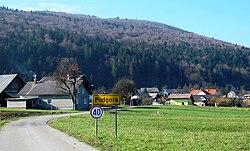|
Podgora, Dobrepolje
Podgora (pronounced [pɔdˈɡɔːɾa]) is a village in the Municipality of Dobrepolje in Slovenia. The area is part of the historical region of Lower Carniola. The municipality is now included in the Central Slovenia Statistical Region.[2] GeographyPodgora is located in the northern part of the Dobrepolje karst polje. It lies in a transitional position between the edge of the polje and the steep slopes of the Little Mountains (Slovene: Mala gora) chain, with inclines up to 29.5°. It is the only village in the polje located almost entirely on Triassic rock. A major Dinaric fault runs past Podgora. The area is rich in springs, with five in Podgora alone. The largest and best-known spring is Žovkno Spring.[3] The other springs are Beč and Zajščica springs in the village itself, nearby Pri Koritu Spring, and Puhovka Spring in Puh Cave (Slovene: Puhova jama) just below the top of Grmada Hill (887 m).[4] HistoryDuring the Second World War, there were several engagements near the village between Italian troops and Partisan forces in 1942. Italian troops burned a number of farms in the village.[4] On the night of 16 June 1945, eight civilians from the village were murdered and buried in the Mala Vas Mass Grave in neighboring Mala Vas.[5] On 21 October 1968 there was a major fire in the village, causing extensive destruction.[4] Church The local church is dedicated to Saint Nicholas and belongs to the Parish of Dobrepolje–Videm.[6] It was first mentioned in written sources in 1526.[4] References
External links
|
||||||||||||||||||||||||||||||
Portal di Ensiklopedia Dunia


